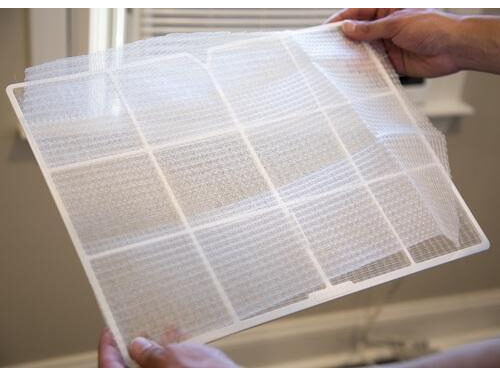Keeping your HVAC system running smoothly starts with one simple component, the air filter. Whether you’re trying to improve air quality, boost efficiency, or cut down on maintenance, understanding the different AC filter types and how they work is the first step to cleaner, healthier air at home.
Why AC Filter Types Matter
Your AC filter is like the lungs of your HVAC system, it catches dust, pollen, pet dander, and other particles before they circulate through your home and clog your equipment. The type determines how fine the filtration is, how much airflow it allows, and how well it protects both your air and your system.
Think of it as more than just a dust trap, it’s a performance regulator. Every bit of airflow your system breathes in passes through that thin sheet of material. A good filter keeps dust off the coils (so they can cool air efficiently), protects the fan motor, and decides whether your home air feels “light and crisp” or “stale and heavy.”
A cheap fiberglass filter protects your equipment but doesn’t do much for air quality, while a higher-grade pleated or electrostatic filter can reduce allergens and fine dust, but only if your system’s airflow can handle it. Find the right balance between filtration and airflow for your specific unit and household.
Understanding the main AC filter types, and knowing how to clean AC filter parts correctly, helps you maintain a clean filter AC unit that runs efficiently and delivers fresher air.
How to Find the Right Filter Size
Check the existing filter’s frame, the size (like 16x20x1) is usually printed on the edge. But don’t trust it blindly; previous homeowners or techs may have used a “close enough” size. If it’s missing or looks off, measure the filter slot itself (length × width × thickness in inches).
A filter that doesn’t fit snugly lets air, and dust, bypass it entirely, sending debris straight into your coils. Don’t “size up” or “size down” just because another filter is on sale. If you’re unsure, your HVAC model number can confirm the correct size through the manufacturer’s website or manual.
Learning about AC filter sizes ensures your replacement fits perfectly, improves airflow, and helps prevent problems like a clogged or dirty filter that could reduce cooling efficiency. When you know how to clean AC filter surfaces and replace them on schedule, your HVAC system will thank you.
HEPA vs. Pleated vs. Electrostatic: AC Filter Types Compared
Most people hear “HEPA” and assume it’s the holy grail, but here’s the real-world breakdown:
HEPA filters trap at least 99.97% of tiny particles (down to 0.3 microns). They’re great for allergy relief but often too restrictive for standard residential HVAC systems unless specifically designed for them. They shine in air purifiers or custom setups.
Pleated filters (usually made from polyester or cotton folds) offer a sweet spot between filtration and airflow. The pleats increase surface area, which means better dust capture and longer life without choking airflow, the “modern standard” for most homes.
Electrostatic filters use static electricity to attract particles. Some are washable, which saves money, but they need regular cleaning to stay effective, skip a cleaning, and performance drops fast. If you’re curious about different AC filter types or wondering how to clean AC filter materials like electrostatics, gentle rinsing is key.
In short: HEPA filters are precision tools, pleated filters are reliable multitaskers, and electrostatics are reusable but high-maintenance. The difference comes down to how each filter balances pollutant capture with proper airflow.
How Often to Change Your AC Filter
A good rule of thumb is every 1-3 months for disposable filters, but lifestyle and location matter more than the calendar. Check it monthly at first to see how quickly it gets dirty, that’s your real schedule.
Change it more often if you have pets that shed, allergies or asthma, construction or dust nearby, or a larger household using the system heavily. On the flip side, high-quality pleated filters or low-traffic homes may stretch up to 6 months between changes.
If the filter looks gray or coated in dust when you hold it to the light, it’s overdue. A one-person condo might go 4-6 months, but a family with pets can see visible buildup in just a few weeks. The filter tells you when it’s ready to go, you just have to look. Knowing how often to change AC filter components based on your air quality prevents airflow restriction and keeps a clean filter AC unit performing at its best.
How to Clean or Replace Your AC Filter (Depending on Type)
It depends on the type.
Disposable filters (fiberglass or pleated) should always be replaced, not cleaned, rinsing them damages the fibers and ruins airflow resistance.
Washable or electrostatic filters can be cleaned, but do it right: rinse gently with mild water pressure (no soap or scrubbing) and let them dry completely before reinstalling. Even a little moisture can lead to mold growth.
If cleaning becomes a chore or the filter looks worn or warped, it’s time to replace it, or switch to high-quality disposables for easier upkeep. If you’ve ever searched how to clean AC filter guides online, you’ve likely noticed that the same advice applies: know your AC filter types and treat each correctly to maintain system efficiency.
How to Change the Filter on an AC Unit
Warning signs include weak airflow from vents, uneven cooling, rising energy bills, musty odors, or your system running louder and longer than usual. The subtle clues often show up first, extra dust on furniture, higher humidity, or your AC sounding like it’s working harder than normal.
Ignoring these signs doesn’t just mean dirty air. A clogged filter forces your AC to work harder, overheat, and can even burn out the blower motor or compressor, the most expensive components to replace. It’s one of the simplest maintenance tasks with the biggest payoff in performance and longevity.
Learning how to change the filter on an AC unit the right way, and checking AC filter sizes for a snug fit, can make all the difference between a system that struggles and one that breathes easily.
Choosing the Right AC Filter for Your Needs
There’s no universal “best”, it all depends on your air and lifestyle.
Pet owners should go for a pleated filter with a higher MERV rating (around 8-12) to catch dander and hair. Allergy or asthma sufferers can benefit from HEPA or high-MERV pleated filters, as long as the system can handle the airflow. For homes exposed to smoke or city air, activated carbon or electrostatic filters help capture fine dust, smoke, and odors. And for vacation homes or low-use systems, a basic fiberglass or standard pleated filter provides light protection.
The key is matching your air needs with your HVAC system’s airflow limits, a filter that’s too dense can actually reduce comfort and efficiency. In short, choose the filter that fits how your home actually lives, not just what’s printed on the box. Knowing your AC filter types and how often to change AC filter units ensures you’ll keep a clean filter AC unit that runs efficiently year-round.
Benefits of a Clean AC Filter
A higher-quality filter keeps your coils and blower cleaner, helping your system run more efficiently over time while preventing fine dust buildup that strains components. Better filters also capture allergens, pet dander, and even some bacteria or smoke particles, leading to noticeably fresher air.
However, going too high on filtration (like installing a dense HEPA in a system not built for it) can restrict airflow and reduce efficiency. The best results come from using the highest-rated filter your system can handle comfortably, and changing it regularly. A mid-to-high MERV pleated filter paired with consistent replacements can lower energy use by keeping coils clean and airflow consistent.
Better filters improve air quality, but it’s your habits, like cleaning return vents and occasionally running the fan, that make those improvements last. When you understand how to clean AC filter parts, recognize different AC filter types, and remember how often to change AC filter units, you’ll maintain a truly clean filter AC unit that performs like new.





